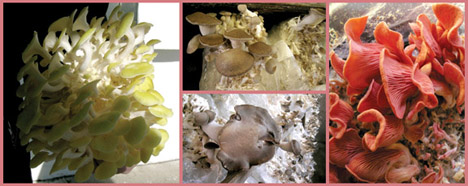I think thereís a mushroom for everyone," Ian Garrone says. That might seem a presumptuous statement, especially if oneís definition of mushroom is derived from what is commonly found at most commercial grocery stores. But hold on, because after seeing and tasting the mushrooms that the Garrones cultivate and sell at Far West Fungi, those impressions are likely to change.

Left: Ian Garrone on the Far West Fungi farm. Right: A mushroom cool-storage, incubation room.
By Michelle Moday
Published: February, 2006
I think thereís a mushroom for everyone, Ian Garrone says. That might seem a presumptuous statement, especially if oneís definition of mushroom is derived from what is commonly found at most commercial grocery stores. But hold on, because after seeing and tasting the mushrooms that the Garrones cultivate and sell at Far West Fungi, those impressions are likely to change.
At the Far West Fungi farm in Monterey County, even the air is different; it smells warm and malty. Itís the hills of wood and bran that stand in front of whitewashed buildings with tin roofs rusted.
Far Westís fungi are wild, medicinal varietals that are grown on all-organic, nutrient-infused, compressed red oak sawdust.
Mother fungus
First, bags are filled with the sawdust mixture, which is compressed and sterilized then moved to a clean room in the onsite lab. This is where the petri dish (a.k.a. mother fungus) is made and kept as the source recipe, and from which a master bag is made and used to create a batch of spores on individual wood blocks.
Itís a careful process. We make our own strains and we keep them on rotation, Garrone says. Selections are only hybrid by traditional means, not engineering. We have our own library. All recipes are batched by ID and dated.
After the spores spawn, they are moved to cool-storage incubation rooms. Incubation is the most delicate stage, Garrone says. Everything has to be very consistent, and handled carefully to avoid bag punctures. Temperatures have to be right around 72 degrees, always. If the temperature rises, molds can grow and kill the fungus; if itís too cold, the fungus may take too long to grow, or not grow at all.
Gestation period is about 13 weeks, although some fungi grow faster than others. While walking through the humid, cool air of a King mushroom storage room, Andy Rizos, who works in the Far West Fungi store says, Kings practically grow before your eyes. Garrone nods and agrees.
Organic philosophy
Last fall, Ianís parents, John and Toby Garrone, the owners of Far West Fungi, traveled to China to attend the Shanghai International Mushroom Conference. One of the main presenters covered the topic of chemicals to be used (in China) for pest control. A list of 24 chemicals was named. An attendee from Holland stood up and asked the question on a lot of peopleís minds: What do you do when every chemical youíve listed is not allowed in our country?
Far West Fungi believes organic is best. No chemicals are used in their growing process. We try to keep people responsible for what chemicals and water they use, Garrone says. When we took over [Hazel Dell Mushrooms] we found out growing organic was cheaper. So, we did what we wanted to do anyway.
Unique medicine
What Far West Fungi does is grow exotic and mostly medicinal mushrooms. Lionís Mane, which looks a bit like coral, or brain, is known to stimulate neurological function and repair brain damage. Bulbous Reishi mushrooms have anti-tumor-cancer-arthritis properties.
Colorful and unique, some of these cap and stems taste like something else. Yellow Oyster mushrooms, eaten raw, taste a lot like cucumber. Lionís Mane, to Garroneís sensitive palate, has a hint of salami flavor and the texture of crabmeat.
Farmerís Market
Far West Fungi started selling mushrooms at the Ferry Building farmerís market, before they set up a full-time shop inside. The Farmerís Market gives us an opportunity to talk to people directly, Garrone says. Weíve had customers who said they hated mushrooms, but hit íem with a Candy CapÖ Whether itís a medicinal mushroom or not, itís a kingdom; youíre going to find one you like.
Photos by Francisco Arreola



